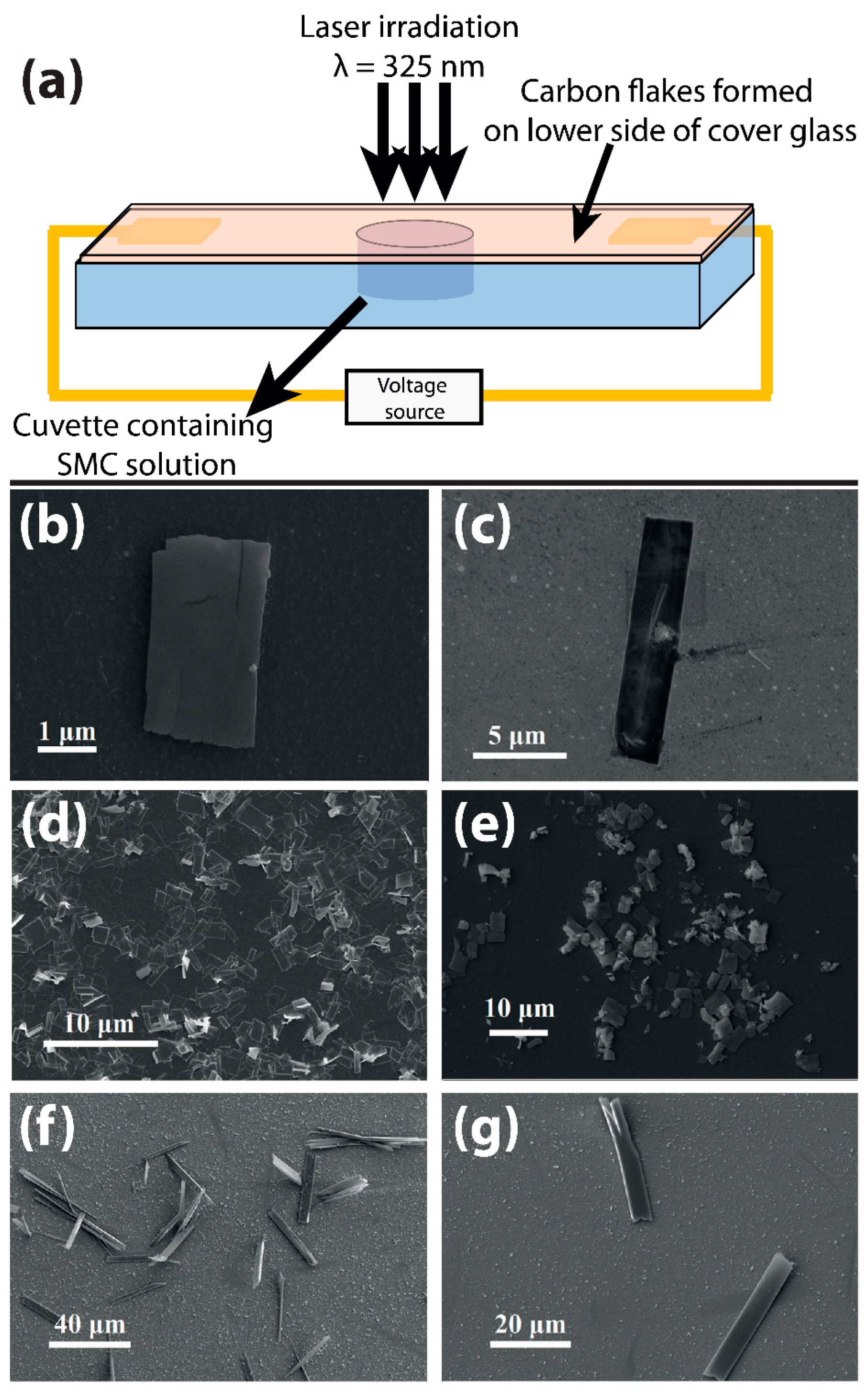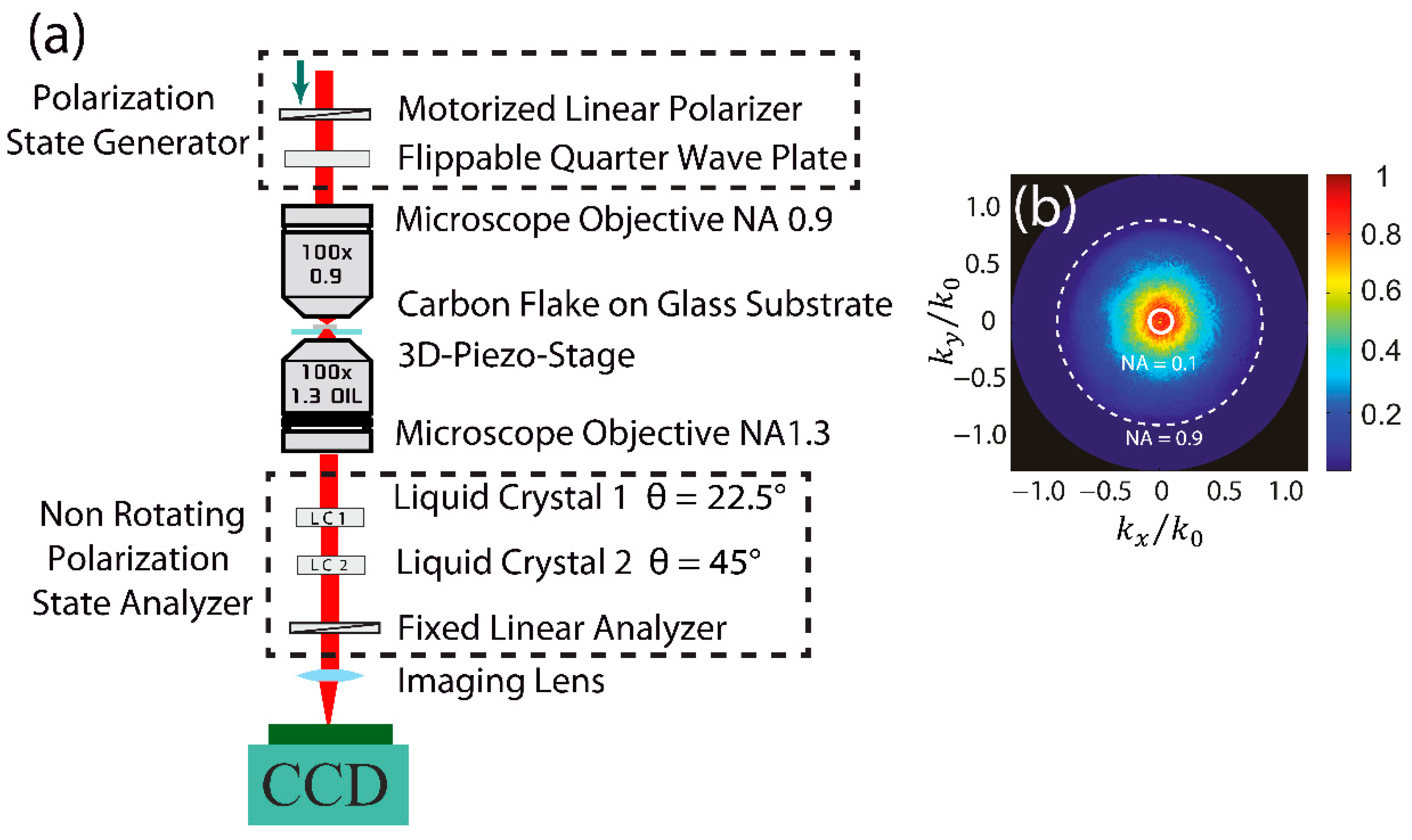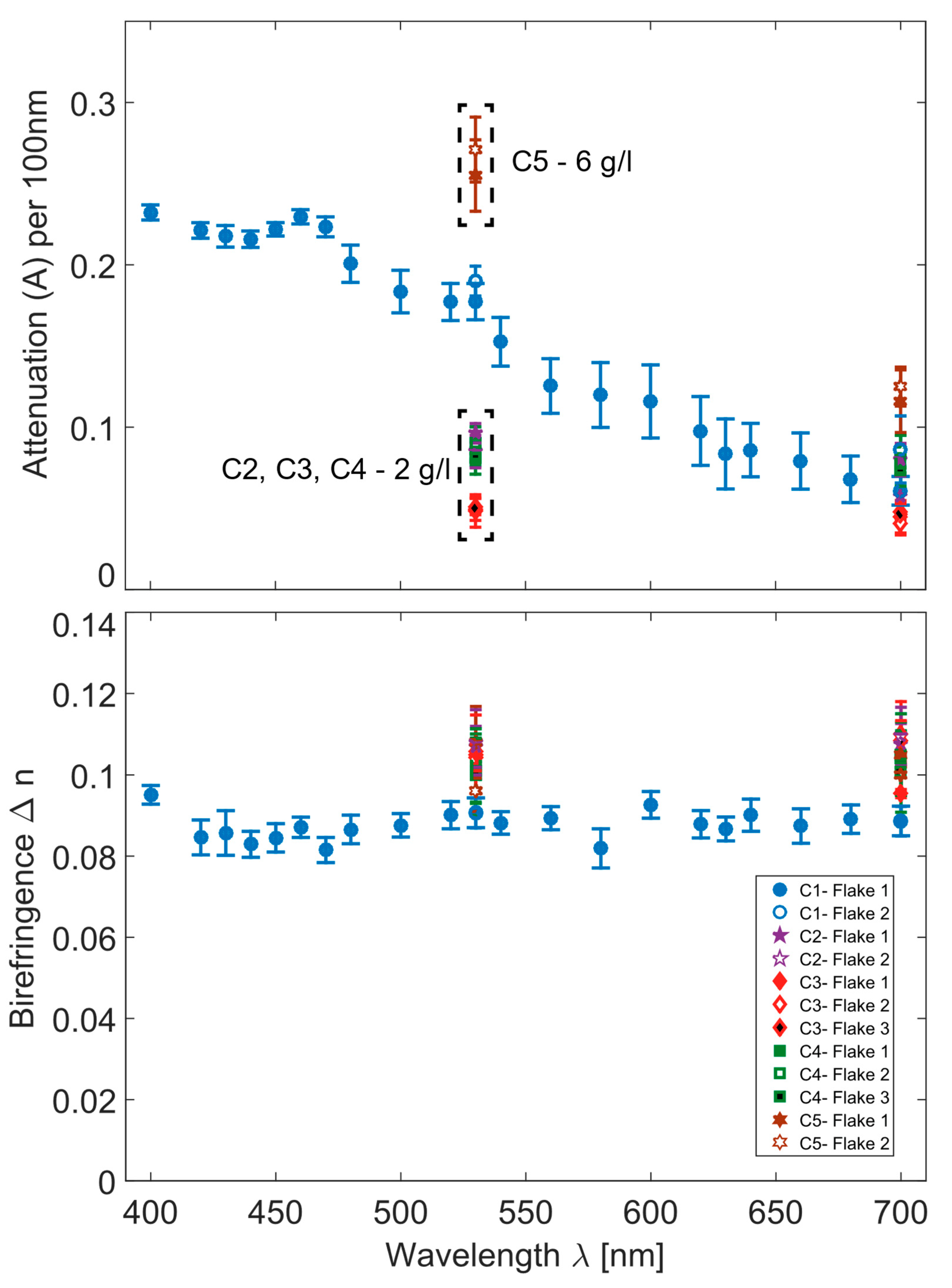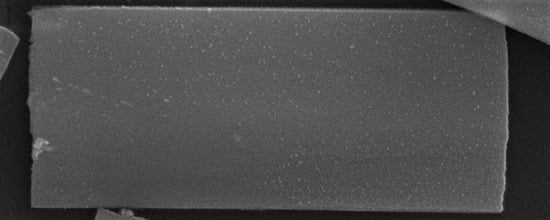Hybrid Orthorhombic Carbon Flakes Intercalated with Bimetallic Au-Ag Nanoclusters: Influence of Synthesis Parameters on Optical Properties
Abstract
1. Introduction
2. Experimental
2.1. Carbon Flakes Fabrication
2.2. Methods
3. Results and Discussion
4. Conclusions
Supplementary Materials
Author Contributions
Funding
Acknowledgments
Conflicts of Interest
References
- Butler, S.Z.; Hollen, S.M.; Cao, L.; Cui, Y.; Gupta, J.A.; Gutiérrez, H.R.; Heinz, T.F.; Hong, S.S.; Huang, J.; Ismach, A.F.; et al. Progress, challenges, and opportunities in two-dimensional materials beyond graphene. ACS Nano 2013, 7, 2898–2926. [Google Scholar] [CrossRef] [PubMed]
- Baron, A.; Aradian, A.; Ponsinet, V.; Barois, P. Self-assembled optical metamaterials. Opt. Laser Technol. 2016, 82, 94–100. [Google Scholar] [CrossRef]
- Neshev, D.; Aharonovich, I. Optical metasurfaces: New generation building blocks for multi-functional optics. Light Sci. Appl. 2018, 7, 1–5. [Google Scholar] [CrossRef]
- Wang, Z.; Li, T.; Soman, A.; Mao, D.; Kananen, T.; Gu, T. On-chip wavefront shaping with dielectric metasurface. Nat. Commun. 2019, 10, 1–7. [Google Scholar] [CrossRef] [PubMed]
- Papaioannou, M.; Plum, E.; Valente, J.; Rogers, W.T.; Zheludev, N.I. Two-dimensional control of light with light on metasurfaces. Light Sci. Appl. 2016, 5, e16070. [Google Scholar] [CrossRef]
- de Leon, I.; Horton, M.J.; Schulz, S.A.; Upham, J.; Banzer, P.; Boyd, R.W. Strong, spectrally-tunable chirality in diffractive metasurfaces. Sci. Rep. 2015, 5, 13034. [Google Scholar] [CrossRef]
- Bashouti, M.Y.; Povolotckaia, A.V.; Povolotskiy, A.V.; Tunik, S.P.; Christ, S.H.; Leuchs, G.; Manshina, A.A. Spatially-controlled laser-induced decoration of 2D and 3D substrates with plasmonic nanoparticles. RSC Adv. 2016, 6, 75681–75685. [Google Scholar] [CrossRef]
- Yu, N.; Capasso, F. Flat optics with designer metasurfaces. Nat. Mater. 2014, 13, 139–150. [Google Scholar] [CrossRef]
- Capasso, F. The future and promise of flat optics: A personal perspective. Nanophotonics 2018, 7, 953–957. [Google Scholar] [CrossRef]
- Su, V.C.; Chu, C.H.; Sun, G.; Tsai, D.P. Advances in optical metasurfaces: Fabrication and applications. Opt. Express 2018, 26, 13148–13182. [Google Scholar] [CrossRef]
- Wang, J.; Du, J. Plasmonic and dielectric metasurfaces: Design, fabrication and applications. Appl. Sci. 2016, 6, 239. [Google Scholar] [CrossRef]
- Park, C.-S.; Shrestha, V.R.; Yue, W.; Gao, S.; Lee, S.S.; Kim, E.S.; Choi, D.Y. Structural color filters enabled by a dielectric metasurface incorporating hydrogenated amorphous silicon nanodisks. Sci. Rep. 2017, 7, 1–9. [Google Scholar] [CrossRef]
- Hong, W.; Bai, H.; Xu, Y.; Yao, Z.; Gu, Z.; Shi, G.J. Preparation of gold nanoparticle/graphene composites with controlled weight contents and their application in biosensors. Phys. Chem. C 2010, 114, 1822–1826. [Google Scholar] [CrossRef]
- Shen, J.; Shi, M.; Li, N.; Yan, B.; Ma, H.; Hu, Y.; Ye, M. Facile synthesis and application of Ag-chemically converted graphene nanocomposite. Nano Res. 2010, 3, 339–349. [Google Scholar] [CrossRef]
- Uslu, B.; Ozkan, S.A. Electroanalytical application of carbon based electrodes to the pharmaceuticals. Anal. Lett. 2007, 40, 817–853. [Google Scholar] [CrossRef]
- Cao, X.; Tan, C.; Sindoro, M.; Zhang, H. Hybrid micro-/nano-structures derived from metal–organic frameworks: Preparation and applications in energy storage and conversion. Chem. Soc. Rev. 2017, 46, 2660–2677. [Google Scholar] [CrossRef]
- Khalil, I.; Julkapli, N.; Yehye, W.; Basirun, W.; Bhargava, S. Graphene–gold nanoparticles hybrid—synthesis, functionalization, and application in a electrochemical and surface-enhanced Raman scattering biosensor. Materials 2016, 9, 406. [Google Scholar] [CrossRef]
- Juang, Z.Y.; Tseng, C.C.; Shi, Y.; Hsieh, W.P.; Ryuzaki, S.; Saito, N.; Hsiung, C.E.; Chang, W.H.; Hernandez, Y.; Han, Y.; et al. Graphene-Au nanoparticle based vertical heterostructures: A novel route towards high-ZT Thermoelectric devices. Nano Energy 2017, 38, 385–391. [Google Scholar] [CrossRef]
- Hajati, Y.; Zanbouri, Z.; Sabaeian, M. Low-loss and high-performance mid-infrared plasmon-phonon in graphene-hexagonal boron nitride waveguide. J. Opt. Soc. Am. B 2018, 35, 446–453. [Google Scholar] [CrossRef]
- Zhang, Z.Y.; Li, D.M.; Zhang, H.; Wang, W.; Zhu, Y.H.; Zhang, S.; Zhang, X.P.; Yi, J.M. Coexistence of two graphene-induced modulation effects on surface plasmons in hybrid graphene plasmonic nanostructures. Opt. Express 2019, 27, 13503–13515. [Google Scholar] [CrossRef]
- Bala, K.; Suriyaprakash, J.; Singh, P.; Chauhan, K.; Villa, A.; Gupta, N. Copper and cobalt nanoparticles embedded in naturally derived graphite electrodes for the sensing of the neurotransmitter epinephrine. New J. Chem. 2018, 42, 6604–6608. [Google Scholar] [CrossRef]
- Povolotckaia, A.; Pankin, D.; Petrov, Y.; Vasileva, A.; Kolesnikov, I.; Sarau, G.; Christiansen, S.; Leuchs, G.; Manshina, A. Plasmonic carbon nanohybrids from laser-induced deposition: Controlled synthesis and SERS properties. J. Mater. Sci. 2019, 54, 8177–8186. [Google Scholar] [CrossRef]
- Manshina, A.A.; Grachova, E.V.; Povolotskiy, A.V.; Povolotckaia, A.V.; Petrov, Y.V.; Koshevoy, I.O.; Makarova, A.A.; Vyalikh, D.V.; Tunik, S.P. Laser-induced transformation of supramolecular complexes: Approach to controlled formation of hybrid multi-yolk-shell Au-Ag@a-C:H nanostructures. Sci Rep. 2015, 5, 12027. [Google Scholar] [CrossRef]
- Manshina, A.; Povolotskaya, A.V.; Petrov, Y.V.; Willinger, E.; Willinger, M.-G.; Banzer, P.; Leuchs, G. Novel 2D carbon allotrope intercalated with Au-Ag nanoclusters: From laser design to functionality. OSA Adv. Photonics 2017. [Google Scholar] [CrossRef]
- Bashouti, M.; Manshina, A.; Povolotckaia, A.; Povolotskiy, A.; Kireev, A.; Petrov, Y.; Mačković, M.; Spiecker, E.; Koshevoy, I.; Tunik, S.; et al. Direct laser writing of μ-chips based on hybrid C–Au–Ag nanoparticles for express analysis of hazardous and biological substances. Lab Chip 2015, 15, 1742–1747. [Google Scholar] [CrossRef] [PubMed]
- Butt, A.; Neugebauer, M.; Lesina, A.C.; Ramunno, L.; Berini, P.; Vaccari, A.; Bauer, T.; Manshina, A.A.; Banzer, P.; Leuchs, G. Investigating the optical properties of a novel 3D self-assembled metamaterial made of carbon intercalated with bimetal nanoparticles. OSA Adv. Photonics 2018. [Google Scholar] [CrossRef]
- Butt, M.A.; Lesina, A.C.; Neugebauer, M.; Bauer, T.; Ramunno, L.; Vaccari, A.; Berini, P.; Petrov, Y.; Danilov, D.; Manshina, A.; et al. Investigating the optical properties of a laser induced 3D self-assembled carbon–metal hybrid structure. Small 2019, 15, 1900512. [Google Scholar] [CrossRef]
- Koshevoy, I.O.; Karttunen, A.J.; Tunik, S.P.; Haukka, M.; Selivanov, S.I.; Melnikov, A.S.; Serdobintsev, P.Y.; Pakkanen, T.A. Synthesis, characterization, photophysical, and theoretical studies of supramolecular gold(I)−silver(I) alkynyl-phosphine complexes. Organometallics 2009, 28, 1369–1376. [Google Scholar] [CrossRef]
- Arteaga, O.; Baldrís, M.; Antó, J.; Canillas, A.; Pascual, E.; Bertran, E. Mueller matrix microscope with a dual continuous rotating compensator setup and digital demodulation. Appl. Opt. 2014, 53, 2236–2245. [Google Scholar] [CrossRef]
- Arteaga, O.; Nichols, S.M.; Antó, J. Back-focal plane Mueller matrix microscopy: Mueller conoscopy and Mueller diffractrometry. Appl. Surf. Sci. 2017, 421, 702–706. [Google Scholar] [CrossRef]
- Bueno, J.M. Liquid-crystal variable retarders for aerospace polarimetry applications. J. Opt. A Pure Appl. Opt. 2000, 46, 689–698. [Google Scholar] [CrossRef]
- Stokes, G.G. On the composition and resolution of streams of polarized light from different sources. Trans. Cambridge Philos. Soc. 1852, 9, 399. [Google Scholar] [CrossRef]
- Wu, S.T.; Efron, U.; Hess, L.D. Birefringence measurements of liquid crystals. Appl. Opt. 1984, 23, 3911–3915. [Google Scholar] [CrossRef] [PubMed]
- Bass, M.; DeCusatis, C.; Enoch, J.; Lakshminarayanan, V.; Li, G.; Macdonald, C.; Mahajan, V.; Stryland, E.V. Polarimetry. In Handbook of Optics Volume II: Design, Fabrication and Testing, Sources and Detectors, Radiometry and Photometry; McGraw-Hill: New York, NY, USA, 2010. [Google Scholar]
- Azzam, R.M.A. Stokes-vector and Mueller-matrix polarimetry. Opt. Soc. Am. 2016, 33, 1396–1408. [Google Scholar] [CrossRef] [PubMed]
- Arteaga, O.; Canillas, A. Analytic inversion of the Mueller–Jones polarization matrices for homogeneous media. Opt. Lett. 2010, 35, 559–561. [Google Scholar] [CrossRef]



| Sample | Laser Irradiation Time (min) | SMC Concentration (g/L) | Electric Field (V/m) | Resulting Thickness of Carbon Flakes (nm) |
|---|---|---|---|---|
| C1 [27] | 15 | 4 * | Off | 150–500 |
| C2 | 40 | 2 | Off | 250–750 |
| C3 | 40 | 2 | On | 250–750 |
| C4 | 80 | 2 | Off | 1200–1700 |
| C5 | 40 | 6 | Off | 150–750 |
| Varied Fabrication Parameter | Effect on Optical Properties of Carbon Flakes | Effect on Geometrical Properties of Carbon Flakes |
|---|---|---|
| Electric field on or off | Optical properties remain unchanged | Lateral elongation of flakes (with field switched on) |
| Laser irradiation time | Optical properties remain unchanged | Increase in thickness with increasing irradiation time |
| SMC concentration | Increase in attenuation with the increasing SMC concentration | No observed effect on structural parameters |
© 2020 by the authors. Licensee MDPI, Basel, Switzerland. This article is an open access article distributed under the terms and conditions of the Creative Commons Attribution (CC BY) license (http://creativecommons.org/licenses/by/4.0/).
Share and Cite
Butt, M.A.; Mamonova, D.; Petrov, Y.; Proklova, A.; Kritchenkov, I.; Manshina, A.; Banzer, P.; Leuchs, G. Hybrid Orthorhombic Carbon Flakes Intercalated with Bimetallic Au-Ag Nanoclusters: Influence of Synthesis Parameters on Optical Properties. Nanomaterials 2020, 10, 1376. https://doi.org/10.3390/nano10071376
Butt MA, Mamonova D, Petrov Y, Proklova A, Kritchenkov I, Manshina A, Banzer P, Leuchs G. Hybrid Orthorhombic Carbon Flakes Intercalated with Bimetallic Au-Ag Nanoclusters: Influence of Synthesis Parameters on Optical Properties. Nanomaterials. 2020; 10(7):1376. https://doi.org/10.3390/nano10071376
Chicago/Turabian StyleButt, Muhammad Abdullah, Daria Mamonova, Yuri Petrov, Alexandra Proklova, Ilya Kritchenkov, Alina Manshina, Peter Banzer, and Gerd Leuchs. 2020. "Hybrid Orthorhombic Carbon Flakes Intercalated with Bimetallic Au-Ag Nanoclusters: Influence of Synthesis Parameters on Optical Properties" Nanomaterials 10, no. 7: 1376. https://doi.org/10.3390/nano10071376
APA StyleButt, M. A., Mamonova, D., Petrov, Y., Proklova, A., Kritchenkov, I., Manshina, A., Banzer, P., & Leuchs, G. (2020). Hybrid Orthorhombic Carbon Flakes Intercalated with Bimetallic Au-Ag Nanoclusters: Influence of Synthesis Parameters on Optical Properties. Nanomaterials, 10(7), 1376. https://doi.org/10.3390/nano10071376







